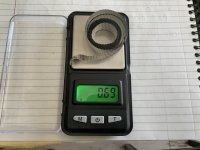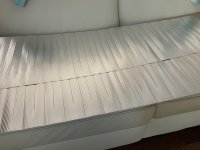I think there is not grams but milligrams or so ??
No, it should be grams. It must exceed the mass of the foil.
The stock Scintilla twt. is .0005” thick
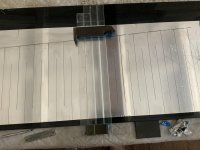
This time around decided on .033” wide cut traces made up of 1/4” acrylic strips glued up to form a framing square and you just move it around to replicate exact magnet rows.
There were 3 rows that were off and closer together so this will shift all rows above those, so it’s important to match and transfer all rows exactly to make the best match per magnet panel.
Center to center magnet length total is 49 13/16”

This time around decided on .033” wide cut traces made up of 1/4” acrylic strips glued up to form a framing square and you just move it around to replicate exact magnet rows.
There were 3 rows that were off and closer together so this will shift all rows above those, so it’s important to match and transfer all rows exactly to make the best match per magnet panel.
Center to center magnet length total is 49 13/16”
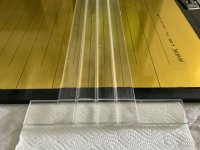
Sanding down all surfaces with 400 grit on an acrylic block takes any rough cut marks down before the Kapton goes down and actually increases impedance slightly as a bonus
This panel wound up at 1 ohm and used the open return field to run some extra traces to bring the panel up to this impedance.
The rebuilt panel that was pulled off measured .9 ohms so I am in the ballpack
And close enough
This cutting template made the whole process much more simple and was able to reduce trace width down significantly compared to the Diva template with the routed traces shhhss , You live and learn..,
Regards
David
Last edited:
I have a question on the air load on this new chassis for the Scintillas and if it might affect Bass response.
As you can see I have run stiffing ribs across and underneath each magnet row the same width as each magnet section
The original had steel flat braces 1” away on the back side area in the same horizontal configuration.
Also the tops and bottom ends of the magnet frame itself never touches the top and bottom frame structure and its the same on the Divas.
I could rout out and area under the steel magnet structure and leave a small center contact area so it can breath better and at the same time connect and glue this area to stiffen the magnet frame and wood frame at the same time
I want to attach top and bottom sections and was considering some big bullnose
reliefs on both sides with say a 2” center attachment area to simulate a more open area like the original design
I have bull nose rounded all the back side cutout area unlike the square edge stock versions and maybe this will aid in air movement in some way
So do you think this might affect air mass loading enough to worry about and if it reduces bass remember the frequency response on this model is set at least 15 dB above the rest of the spectrum and maybe a reduction is a plus here ?
Welcome some opinions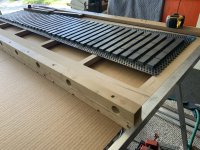
As you can see I have run stiffing ribs across and underneath each magnet row the same width as each magnet section
The original had steel flat braces 1” away on the back side area in the same horizontal configuration.
Also the tops and bottom ends of the magnet frame itself never touches the top and bottom frame structure and its the same on the Divas.
I could rout out and area under the steel magnet structure and leave a small center contact area so it can breath better and at the same time connect and glue this area to stiffen the magnet frame and wood frame at the same time
I want to attach top and bottom sections and was considering some big bullnose
reliefs on both sides with say a 2” center attachment area to simulate a more open area like the original design
I have bull nose rounded all the back side cutout area unlike the square edge stock versions and maybe this will aid in air movement in some way
So do you think this might affect air mass loading enough to worry about and if it reduces bass remember the frequency response on this model is set at least 15 dB above the rest of the spectrum and maybe a reduction is a plus here ?
Welcome some opinions

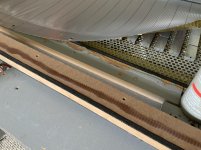
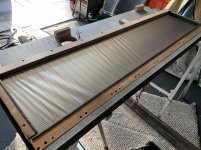
Thanx Pete. The reason yours had these ripples is sections pulled loose .
I was able to pull both speaker foils from the silicone without damaging either one.
Perhaps the installer (2008) assumed new foils were already clean before applying silicone and maybe
a good cleaning with acetone would have gotten them further along
I shouldn’t have been able to peel these free so easily.
Thinking about this for those with decent panels but bad foam and the possibility of removing them intact to be reused , reformed and reglued again , I was able to remove the Diva panels and also the Graz Scintilla panels rather easily.
Important points would be to take your time , have a spare room with at least a 3 X 7 foot table with saw horses, no pets or birds to land on your panels and no kids to get into the area.
With the idea that if this doesn’t work and you destroy a panel , at least panels are available posted by artm in pg #233 which is fantastic news and decent prices
for those wanting to diy
Important points would be to take your time , have a spare room with at least a 3 X 7 foot table with saw horses, no pets or birds to land on your panels and no kids to get into the area.
With the idea that if this doesn’t work and you destroy a panel , at least panels are available posted by artm in pg #233 which is fantastic news and decent prices
for those wanting to diy
Hey. I planned the construction of the bass panel.
I have already done mid panels and a tweeters.
My question would be as follows. Or there may be more than one.
Apogen panels are very low ohmic.
Is the reason for this that the availability of higher power magnets at that time has been poor. I assume that apogee has used ferrite magnets.
my purpose would be to build panels with neodymium magnets.
to be able to make the panels a little amplifier friendly.
and more sensitive. Has anyone tried any of these.
how far apart those apogen magnets are. I assume the magnets are 20x50x10mm. how large is the apogen largest panel. height, width at bottom, width at top.
how long is one magnet line. I assume the width at the bottom is about 40cm and the magnets 25cm. how thick is the perforated plate behind the magnets. and how big the holes are in it.
I have already done mid panels and a tweeters.
My question would be as follows. Or there may be more than one.
Apogen panels are very low ohmic.
Is the reason for this that the availability of higher power magnets at that time has been poor. I assume that apogee has used ferrite magnets.
my purpose would be to build panels with neodymium magnets.
to be able to make the panels a little amplifier friendly.
and more sensitive. Has anyone tried any of these.
how far apart those apogen magnets are. I assume the magnets are 20x50x10mm. how large is the apogen largest panel. height, width at bottom, width at top.
how long is one magnet line. I assume the width at the bottom is about 40cm and the magnets 25cm. how thick is the perforated plate behind the magnets. and how big the holes are in it.
The price of neodymium is about ten times the price of ferrites of the same size. The drivers use to be about 25 cm at the top and 35 cm at the bottom. In the eighties people used 40x25x10 mm ferrites in copies of the Apogee. I think there is a delicate balance between the magnetic field strength, the impedance of the conductor on the diaphragm and the bass response. If the magnetic field strength is too large, maybe the neccessary peak (large Q) in the bass weakens?
The Diva as an example is an easy speaker to drive with no serious phase angles to worry about although those flea watt tube amps need not apply if that’s what you mean..,
The magnet size on the Diva is 2.530” X .806” X .450” thick (174 magnets per speaker)
Top to bottom Ctr. To Ctr. Spacing is 64 1/4”
The Scintilla (1 ohm) on the other hand will make your amps cry for mommy
I am in the process of keeping the original crossover along with a biamp capability by adding outside foils in series to bring both bass and mid to 2 ohms as the class D amps current limit at 1 ohm but not 2. The stock mid has a .9 ohm
foil in series to bring it up to the bass panels
The Scintilla magnets are 1 7/8” X 7/8” X 7/16” thick
Top to bottom Ctr. To Ctr. is 49 13/16” with 1/2” spacing
nobody will be diying this speaker any time soon
The perforated steel of both the Diva/ Scintilla is .100” thick and not certain of the open area percentage.
A neo version of a Scintilla would be nice and believe Graz has extremely expensive versions with neo magnets if flea power is your thing, although class D
is now cheap so why build an expensive neo speaker ?
Regards
David
The magnet size on the Diva is 2.530” X .806” X .450” thick (174 magnets per speaker)
Top to bottom Ctr. To Ctr. Spacing is 64 1/4”
The Scintilla (1 ohm) on the other hand will make your amps cry for mommy
I am in the process of keeping the original crossover along with a biamp capability by adding outside foils in series to bring both bass and mid to 2 ohms as the class D amps current limit at 1 ohm but not 2. The stock mid has a .9 ohm
foil in series to bring it up to the bass panels
The Scintilla magnets are 1 7/8” X 7/8” X 7/16” thick
Top to bottom Ctr. To Ctr. is 49 13/16” with 1/2” spacing
nobody will be diying this speaker any time soon
The perforated steel of both the Diva/ Scintilla is .100” thick and not certain of the open area percentage.
A neo version of a Scintilla would be nice and believe Graz has extremely expensive versions with neo magnets if flea power is your thing, although class D
is now cheap so why build an expensive neo speaker ?
Regards
David
Last edited:
Here, I can see 204 magnets on each bass driver of the Diva.
Apogee Diva – Inside Pictures | HFA - The Independent Source for Audio Equipment Reviews
Apogee Diva – Inside Pictures | HFA - The Independent Source for Audio Equipment Reviews
- Home
- Loudspeakers
- Planars & Exotics
- Anyone making Apogee bass panels?
